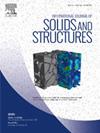Elastic sheets on Winkler foundations: Indentation stiffness and nonlinearities
IF 3.4
3区 工程技术
Q1 MECHANICS
International Journal of Solids and Structures
Pub Date : 2025-03-26
DOI:10.1016/j.ijsolstr.2025.113346
引用次数: 0
Abstract
The indentation of thin sheets on Winkler’s mattress or elastic foundations offers valuable opportunities to gain quantitative insights into the mechanical properties of both the material and its interface. However, interpreting indentation data is complicated by the interplay of plate bending, sheet pre-tension, and foundation deformation. The challenges are further amplified in recently developed nanoindentation techniques for small-scale systems, such as 2D materials and cell membranes, where indenter size, shape, and foundation nonlinearity have been found to influence the results significantly. Here, we address these challenges by investigating a generalized indentation problem involving a pre-tensioned elastic sheet on a mattress foundation, considering both punch and spherical indenters. By linearizing the Föppl–von Kármán equations and the elastic foundation under small indentation depth, we obtain a set of asymptotic solutions that quantify the effects of pre-tension and indenter geometry on indentation stiffness. These solutions show excellent agreement with numerical solutions in various parameter regimes that we classify. We also discuss sources of nonlinearities arising from the kinematics in sheet stretching and the evolving contact radius in spherical indentation. The results should be of direct use for the nanometrology of layered materials where indentation remains one of the most accessible techniques for characterizing mechanical properties at small scales.
温克勒地基弹性板:压痕刚度和非线性
温克勒床垫或弹性基础上薄片的压痕提供了宝贵的机会,可以定量地了解材料及其界面的机械性能。然而,由于板弯曲、板预张力和基础变形的相互作用,解释压痕数据是复杂的。在最近开发的用于小规模系统(如二维材料和细胞膜)的纳米压痕技术中,挑战进一步扩大,其中压痕的尺寸,形状和基础非线性已被发现对结果有显着影响。在这里,我们通过研究涉及床垫基础上的预张紧弹性板的广义压痕问题来解决这些挑战,同时考虑了冲压和球形压痕。通过线性化Föppl-von Kármán方程和小压痕深度下的弹性基础,我们得到了一组渐进解,量化了预张力和压痕几何形状对压痕刚度的影响。这些解与我们分类的各种参数下的数值解表现出极好的一致性。我们还讨论了板料拉伸运动和球面压痕接触半径变化引起的非线性的来源。该结果将直接用于层状材料的纳米计量学,其中压痕仍然是表征小尺度机械性能的最容易获得的技术之一。
本文章由计算机程序翻译,如有差异,请以英文原文为准。
求助全文
约1分钟内获得全文
求助全文
来源期刊
CiteScore
6.70
自引率
8.30%
发文量
405
审稿时长
70 days
期刊介绍:
The International Journal of Solids and Structures has as its objective the publication and dissemination of original research in Mechanics of Solids and Structures as a field of Applied Science and Engineering. It fosters thus the exchange of ideas among workers in different parts of the world and also among workers who emphasize different aspects of the foundations and applications of the field.
Standing as it does at the cross-roads of Materials Science, Life Sciences, Mathematics, Physics and Engineering Design, the Mechanics of Solids and Structures is experiencing considerable growth as a result of recent technological advances. The Journal, by providing an international medium of communication, is encouraging this growth and is encompassing all aspects of the field from the more classical problems of structural analysis to mechanics of solids continually interacting with other media and including fracture, flow, wave propagation, heat transfer, thermal effects in solids, optimum design methods, model analysis, structural topology and numerical techniques. Interest extends to both inorganic and organic solids and structures.

 求助内容:
求助内容: 应助结果提醒方式:
应助结果提醒方式:


